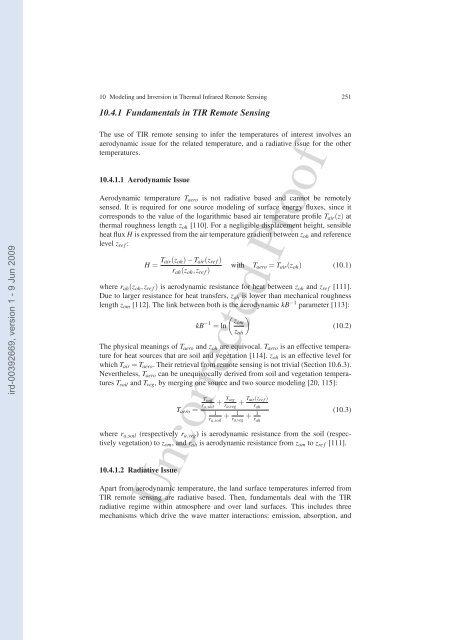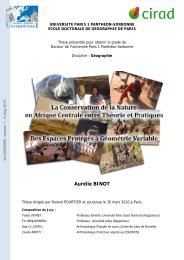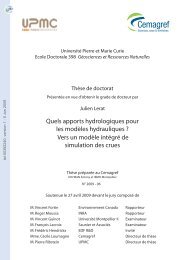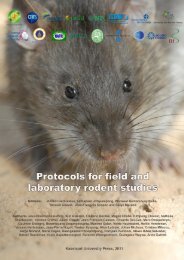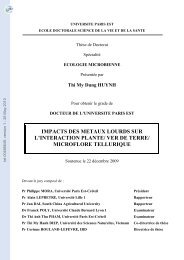Modeling and Inversion in Thermal Infrared Remote Sensing over ...
Modeling and Inversion in Thermal Infrared Remote Sensing over ...
Modeling and Inversion in Thermal Infrared Remote Sensing over ...
Create successful ePaper yourself
Turn your PDF publications into a flip-book with our unique Google optimized e-Paper software.
10 <strong>Model<strong>in</strong>g</strong> <strong>and</strong> <strong>Inversion</strong> <strong>in</strong> <strong>Thermal</strong> <strong>Infrared</strong> <strong>Remote</strong> Sens<strong>in</strong>g 25110.4.1 Fundamentals <strong>in</strong> TIR <strong>Remote</strong> Sens<strong>in</strong>gird-00392669, version 1 - 9 Jun 2009The use of TIR remote sens<strong>in</strong>g to <strong>in</strong>fer the temperatures of <strong>in</strong>terest <strong>in</strong>volves anaerodynamic issue for the related temperature, <strong>and</strong> a radiative issue for the othertemperatures.10.4.1.1 Aerodynamic IssueAerodynamic temperature T aero is not radiative based <strong>and</strong> cannot be remotelysensed. It is required for one source model<strong>in</strong>g of surface energy fluxes, s<strong>in</strong>ce itcorresponds to the value of the logarithmic based air temperature profile T air (z) atthermal roughness length z oh [110]. For a negligible displacement height, sensibleheat flux H is expressed from the air temperature gradient between z oh <strong>and</strong> referencelevel z re f :H = T air(z oh ) − T air (z re f )r ah (z oh ,z re f )with T aero = T air (z oh ) (10.1)where r ah (z oh ,z re f ) is aerodynamic resistance for heat between z oh <strong>and</strong> z re f [111].Due to larger resistance for heat transfers, z oh is lower than mechanical roughnesslength z om [112]. The l<strong>in</strong>k between both is the aerodynamic kB −1 parameter [113]:( )kB −1 zom= ln(10.2)z ohThe physical mean<strong>in</strong>gs of T aero <strong>and</strong> z oh are equivocal. T aero is an effective temperaturefor heat sources that are soil <strong>and</strong> vegetation [114]. z oh is an effective level forwhich T air = T aero . Their retrieval from remote sens<strong>in</strong>g is not trivial (Section 10.6.3).Nevertheless, T aero can be unequivocally derived from soil <strong>and</strong> vegetation temperaturesT soil <strong>and</strong> T veg , by merg<strong>in</strong>g one source <strong>and</strong> two source model<strong>in</strong>g [20, 115]:T aero =T soilr+ T vega,soil r a,veg+ T air(z re f )r ah1r+ 1a,soil r a,veg+ 1r ah(10.3)where r a,soil (respectively r a,veg ) is aerodynamic resistance from the soil (respectivelyvegetation) to z om , <strong>and</strong> r ah is aerodynamic resistance from z om to z re f [111].10.4.1.2 Radiative IssueApart from aerodynamic temperature, the l<strong>and</strong> surface temperatures <strong>in</strong>ferred fromTIR remote sens<strong>in</strong>g are radiative based. Then, fundamentals deal with the TIRradiative regime with<strong>in</strong> atmosphere <strong>and</strong> <strong>over</strong> l<strong>and</strong> surfaces. This <strong>in</strong>cludes threemechanisms which drive the wave matter <strong>in</strong>teractions: emission, absorption, <strong>and</strong>Uncorrected Proof


